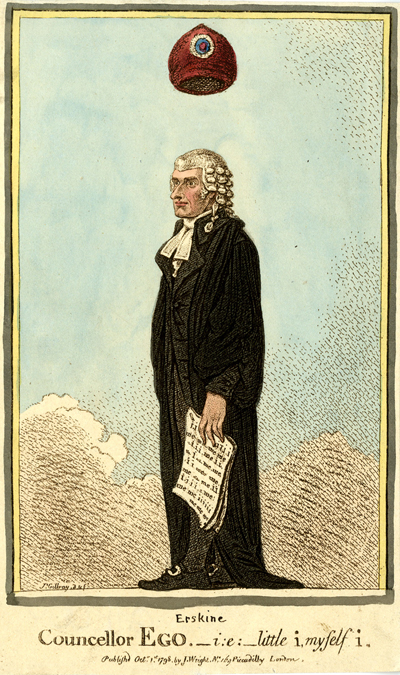Councellor Ego, i.e. little i, myself i
This print was created to accompany a "soliloquy" printed in the September issue of the Anti-Jabobin Review and Magazine that was supposedly overheard "on the morning appointed for the trial of Mr. [Joseph] Johnson, the bookseller" for seditious libel. It features Thomas Erskine, the well-known Whig barrister who had made a name for himself defending radicals such as Thomas Paine, John Thelwall, and Horne Tooke against prosecutions by an increasingly nervous and repressive Pitt government. Erskine had been in the news recently not only for his (ultimately unsuccessful) defence of Johnson, the liberal bookseller, but also for his evidence to character in the trial of the Irish revolutionary, Arthur O'Connor in late May of 1798.

© Trustees of the British Museum
As demonstrated in the supposed "soliloquy," Erskine was capable of thinking well of himself in every case (nominative, genitive, dative, accusative, and ablative) of the Latin pronoun ego.
Who is is the first lawyer at the British bar? EGO
Of whom do I principally speak, in court, the senate, the tavern? MEI
To whom is pre-eminence due as a political writer. MIHI
Whom do unfortunate patriots regard as their first patron and most successful defender? ME . . .
By whom was France enlightened as the real state of England and Ireland? A ME
In presenting the Whig Lawyer as a lower case i with a revolutionary cap of liberty providing the dot, Gillray has not only found the perfect graphic equivalent of Erskine's relentless egotism, he is no doubt remembering Hogarth's remark in the Inscription to The Bench (1758) about the excellence of caricature. Hogarth argued that unlike the portrayal of character,
all the humorous effects of the fashionable manner of caricaturing chiefly depend on the surprise we are under at finding ourselves caught with any sort of similitude in objects absolutely remote in their kind. Let it be observed, the more remote in their nature, the greater is the excellence of these pieces. As a proof of this, I remember a famous caricature of a certain Italian singer, that struck at first sight, which consisted only of a straight perpendicular line with a dot over it.
By that (or really any) standard, Gillray's satiric portrait caricature of Erskine is wonderfully inventive and simply excellent.
Sources and Reading
- Commentary from the British Museum on Councellor Ego, i.e. little i, myself i.
- "Thomas Erskine, 1st Baron Erskine," Wikipedia
- "Counsellor Ego," The Anti-Jacobin Review and Magazine
Comments & Corrections
NOTE: Comments and/or corrections are always appreciated. To make that easier, I have included a form below that you can use. I promise never to share any of the info provided without your express permission.